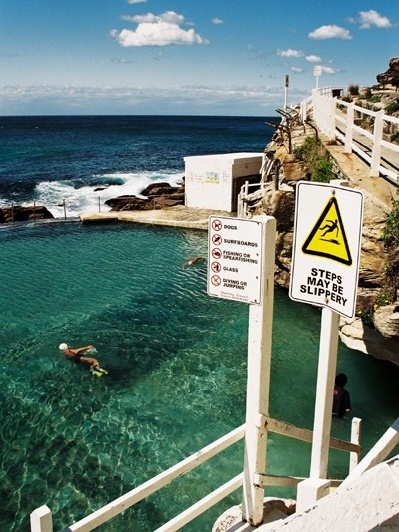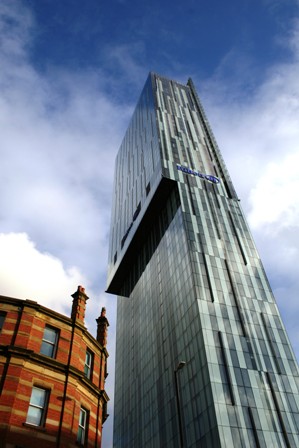
Everyday swimming: the weather can help
One day for Everyday Swimming
The Amateur Swimming Association hosted a one-day seminar in Manchester to explore the impact of its Everyday Swimming initiative. Mick Owen dropped in to hear the results

Everyday swimming: the weather can help
From a chuntering commuter train on a chill Monday morning the sight of the watery Manchester sunlight catching the faceted surface of the Hilton Tower is genuinely inspirational. The building has been called iconic. It has also been called an “oversized tooth” and a “monstrosity”. With the low sun glancing off its mirrored exterior a trick of the light makes it look bodged together with vertical strips of white gaffer tape. But whatever your aesthetic take on the highest rise of an otherwise low-key skyline, the tower draws the eye and is a soaring beacon for the regeneration of a city, the catalyst for which was an IRA bomb.
Fighting back could be the theme for the day and the place of icons in the process a motif. The seminar on offer in the elegant setting of the Hilton itself – the top half of the tower is taken up with footballer-occupied apartments – has been organised by the Amateur Swimming Association (ASA) to both explain and progress its Everyday Swim initiative by picking the bones out of their final report which asks the question: “Still treading water or making waves in swimming participation?”
On the platform is none other than Duncan Goodhew, as notable for his hairless head as for his Olympic medal and retained by the ASA as an ambassador for the Everyday Swim programme which has cost £3 million and consisted of placing co-ordinators in nine different local authorities to see what worked. The end of term report, available in every conceivable format, simply says what works and what doesn’t. The refreshing admission that not everything went perfectly whets the appetite for the detail but first the audience of some 60 souls must get past Goodhew. Introductions are effected by Matt McFahn, the ASA regional director for what he calls “the Great North West”, who welcomes all present to the seminar, the Hilton – whose interior décor both chimes with the rectilinear design of the tower and more serendipitously matches the ASA’s aqua – and to Manchester. He also introduces members of the ASA “team” who on a swift head count make up 15% of the audience. The phrase ‘preaching to the converted’ springs to mind and Ambassador Goodhew does little to drive it out. Especially the ‘preaching’ part. We live in a world where gold medals are losing their currency and where “inspirational speakers” are made not born. Every Olympic medallist, world champion and even their coaches are being given an hastily bespoke copy of Inspiration: the Presentation and sent on the road. Goodhew’s spiel is standard fare, drawing on his experiences as a youngster, including the requisite triumph over adversity (dyslexia in his case), and highlighting words such as ‘empowerment’, ‘empathy’ and ‘challenge’. The closest he gets to ‘moving’ is when he talks about water: “It’s alive, it moves, it assaults all the senses, neutralises gravity and we can escape the hardness of the real world and move freely.” And his passion shines through.
His passion also makes itself known when he talks about why the Everyday Swim scheme must succeed. His thesis goes something like this: swimming gets a lot of money from Sport England to deliver against the national agency’s participation targets, only swimming can do this (thanks to British Gas) and swimming must fight off the claims of parvenu mass participation sports like cycling who “have a little edge with their sustainable transport thing”. He even points out that far more people get hurt cycling (or perhaps stopping cycling suddenly) but that swimming is injury-free. This is disappointingly parochial for the icon who founded the Youth Sport Trust and when you add the line “Free swimming is not something that we do naturally” the temptation to bastardise the Bible becomes too much: “By their throwaway lines shall you know them.”
It is always valuable to encounter someone with something to say and Simon Shibli of Sheffield Hallam has a list. With diagrams, data sets and a down-to-earth style, he engages his audience effortlessly; when did monitoring and evaluation get interesting? Shibli shares Goodhew’s conviction that “nothing other than swimming will do it” where “it” is deliver Sport England’s targets for participation. Swimming has the “highest latent demand” of all sports, with 13% of people surveyed saying they would go swimming if they could, but it also suffers from “the perception that swimming is an inferior product” compared to gym membership. The Everyday Swim project set out to enable that 13% to get in the swim while changing that perception.
Bold aims for a project on a bold scale that aimed to harness the nation’s – or at least its politicians’ – obsession with public health. Obesity is currently one of the most abused terms in the public realm after “we’re in it together” and its currency is fading like a jaded icon. When all is said and done, swimming is a pleasant enough activity but it would have to be a golden bullet tipped with magic potion to do everything the ASA claim. Everyday Swim: the DVD lays claim to efficacy in the following areas: obesity, healthier lifestyle, community engagement, public service, more medals and increased revenue. Quite why we are not building swimming pools in Afghanistan is not explained. Perhaps because the percentage of the population that go swimming has actually dropped in the last year? This seems to be the statistical case but pool managers report no shortening of queues and no slackening of demand from swimming, water polo and sub aqua clubs. Perhaps, offers Shibli in the style of a rabbit-producing magician, it is because the base population grew and the same participation numbers appear proportionately smaller. But this is not the Great Shibli’s only trick. Alluding to his presumably glamorous assistants waiting in the seminar rooms, he promises the blueprints for success later but does give the headlines.
“Have a clear business strategy”, “diversify” and “culture change” all feature; so far, so railway station bookshop business section. But then he gets on to what worked on the ground. Under “market development” he advises both market penetration – which means getting the same swimmers to swim more often – and product development. Swimming, it seems, is not just swimming. There is the Gospel Swim that married an African-Caribbean community’s love of choral singing with a swimming pool; and worked. Having a cup of tea with a teacher was cited as a useful strategy, as was harnessing the power of “people like me” in poster advertising. Selling things like the Liquid Swim, which “brings the gym culture to the pool”, was held to be a good thing, as was getting your targets lined up. One “much-buried piece of research” is, according to Shibli, that 21% of adults can not swim, a figure that rises with age to 40%. “What is the point,” he asks, “of promoting free swimming to a population [the over-60s] where 40% can not use it ?” Disappointingly for Goodhew and his fellow travellers in the accounts department, his answer is not to stop free swimming but to offer swimming lessons for old folk in free swimming sessions; and if you charge for the tuition everybody’s happy.
Of course, to do that you would need enough swimming teachers who knew how to work with people of advancing years. They don’t take kindly to having their legs moved about like a frog, you know. “Upskilling your team” becomes important until they are “fit for purpose” and since the purpose is filling swimming pools one skill being ‘upped’ should be cross-selling. To give his point extra power Shibli cites DC Leisure, who are “exploiting free swimming by using it to get people through the doors and then selling them something else”.
Shibli’s presentation is full of information: the data, the examples, the admission that Sheffield Hallam were miffed not to have won the contract to evaluate the free swimming initiative. And the damning indictment of unimaginative managers who have simply accepted that free swimming means no more than transferring the payment from the swimmer to the government in an act of “reactive compliance”. They should, he argues, be seeking the nirvana of “pro-active development”, using the change in circumstance as a catalyst for some imaginative programming, backed by innovative marketing; by which he does not mean a small poster in the foyer that only existing users will see.
The blueprint revealed in the three break outs must remain a mystery as unfortunately The Leisure Review was forced to make its excuses and leave; but it left with the curious intent of getting back to the pool and getting more people in using Shibli’s formula, or the part thereof that makes sense locally. Icons can be inspiring but they can also be blocks of wood carrying out-dated imagery that hark back to faded and forgotten glories. Statistics can be boring but they can also be potent indicators of things achieved and things yet to be achieved.
The Leisure Review, November 2009
© Copyright of all material on this site is retained by The Leisure Review or the individual contributors where stated. Contact The Leisure Review for details.
Download a pdf version of this article for printing
